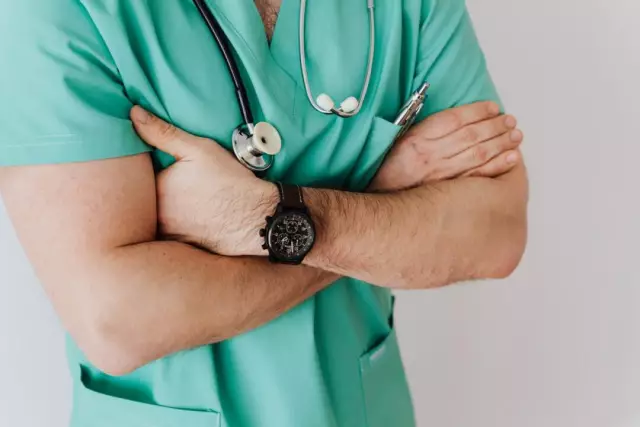- Author Curtis Blomfield [email protected].
- Public 2023-12-16 20:44.
- Last modified 2025-01-23 17:01.
If you began to notice soreness in your right side, a taste of bitterness appeared in your mouth, often you start to feel sick for no reason, then there is a high probability that these are problems with the liver. But do not start guessing on coffee grounds and take advertised drugs. It is better to consult a specialist and conduct an examination of the liver. Only after examining the results of tests, ultrasound, CT, MRI, radioisotope scanning or biopsy, can the correct treatment be prescribed.

CBC
Typically, the first step in a liver exam is a test. First of all, doctors always prescribe a general blood test. This is the simplest study that does not indicate a specific problem, but will make it possible to determine the presence of inflammation of the organ. And if a decrease in the level of platelets is detected, then we can assume viral hepatitis, since the work of liver cells is disrupted.

Biochemistry
You will have to donate blood from a vein, which will determine liver enzymes (aspartate aminotransferase and alanine aminotransferase). This analysis allows you to judge damaged cell membranes that allow special cellular enzymes to pass from the liver into the blood. The norm of these enzymes is less than 41 U / l ALT. If it is exceeded, then this may be a sign of hepatitis of various forms. This analysis is called blood biochemistry. It allows you to determine the ratio of ALT, AST, identify alkaline phosphatase and determine the level of bilirubin, evaluate the concentration of gamma-glutamyl transferase (GGTP). More than 40 indicators are determined by analysis.

Ultrasound
An important step in the examination of the liver is ultrasound. Ultrasound diagnostics allows you to determine the size of the liver and gallbladder. The method shows such diffuse changes as hepatosis, all types of pancreatitis, cirrhosis. So, for example, with hepatosis, blotches of fat cells will be noticeable in the organ. Hepatocytes and fat have different densities, which means that the ultrasound picture will look colorful. And as the disease progresses, liver cells will begin to be replaced by connective tissue, and ultrasound will show signs of fibrosis.
As for focal changes, an ultrasound examination of the liver will clearly show areas with increased density, which may turn out to be hemangioma, adenoma, metastases of a cancerous tumor, calcifications. Also, the method clearly allows you to determine the reduced echogenicity of the areas, which may indicate the presence of sarcoma, lymphoma, abscess or hematoma.

After studying the data obtained, the doctor will not be able to make an accurate diagnosis, but he determines the direction for further examination of the liver, excluding rejected options.
For a patient, such a study is completelypainlessly. But it will take a little preparation, excluding flatulence.
Computerized scintigraphy and isotope scanning
Modern methods of examining the liver include radioisotope scanning or more recent computerized scintigraphy of the organ system, including the liver, gallbladder and ducts. The first method has been actively used in medical practice since the early 60s and has somewhat lost its relevance. The second method appeared relatively recently and has already gained popularity among diagnosticians. The study allows you to assess the degree of functioning of the organ, determine its size, identify neoplasms and establish the presence of chronic processes.
Scintigraphy is carried out using colloidal sulfur (or other organic matter), which is labeled with radioactive technetium 99. The radioactive isotope is administered to the patient intravenously or by inhalation. Then, using a gamma camera, the radiation is captured, converted and transmitted to a computer. The image is layered and colored. The examination takes up to 30 minutes, allowing the doctor to control the work of the organ and obtain information about pathologies.

Isotope scanning is also performed for 30-40 minutes, but requires the patient to be completely immobile. A flat image is displayed on paper, not on a screen. These are colored crosshatched lines.
Both research methods are performed on an empty stomach. No other special training is needed.
CT and MRI
There are two more modern, but moreexpensive method of examining the liver - computed and magnetic resonance imaging. CT is performed using X-rays. As a result of the procedure, up to twelve images (horizontal sections) are obtained, which makes it possible to determine the location and size of lesions. In addition, the doctor gets the opportunity to assess the nature of the problem and understand how it affected the surrounding tissues. CT is prescribed for suspected obstructive jaundice, cyst, liver injury, bleeding, hematomas, cirrhosis and tumors.
MRI is deservedly considered the most accurate method of examining the liver and other organs. Magnetic resonance imaging as accurately as possible reveals neoplasms, even of a very small size. At the same time, during the procedure, it is possible not only to diagnose a tumor, but also to establish its nature, detect metastases, assess vascular patency, detect diffuse changes, determine the degree of cirrhosis, and much more. The examination is carried out in a special apparatus of the tunnel type. The procedure takes 30 minutes or more.

Diagnosis can be done with or without contrast. The method is absolutely safe for patients, but requires control of metal objects. Everything must be removed: jewelry, hearing aids, and removable dentures. MRI in the presence of shrapnel wounds, metal staples or pins and a pacemaker is possible only after additional consultation with a doctor.
Biopsy
Biopsy provides an opportunity to determine the etiologydisease, its stage and level of organ damage. A piece of living tissue is taken for analysis, which is sent for histological (tissue), cytological (cellular) or bacteriological examination.
There are several types of liver biopsy:
- puncture;
- suction with ultrasound control;
- transvenous;
- laparoscopic.

Preparation for a planned liver biopsy begins 7 days in advance. The patient must refuse to take non-steroidal anti-inflammatory drugs and warn about taking anticoagulants. For 5 days, foods that increase gas formation are excluded from the diet. For 3 days, start taking "Espumizan". The procedure is performed on an empty stomach.
The main thing that the patient should understand is that if pain and unpleasant symptoms occur, it is impossible to delay the visit to the doctor. It is necessary to conduct an examination of the liver. Where to start, the attending physician must decide, since he will need a complete picture of the state of the organ. Remember, most problems can be cured with timely help.






